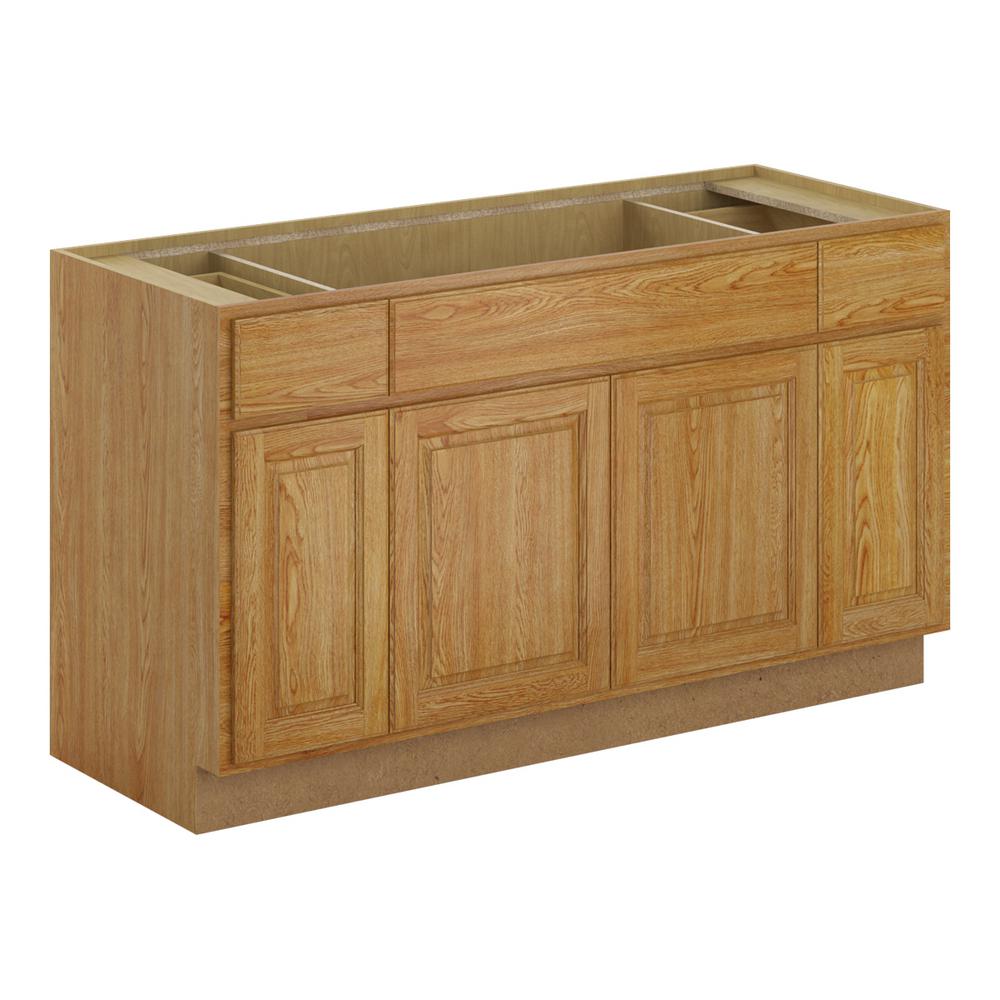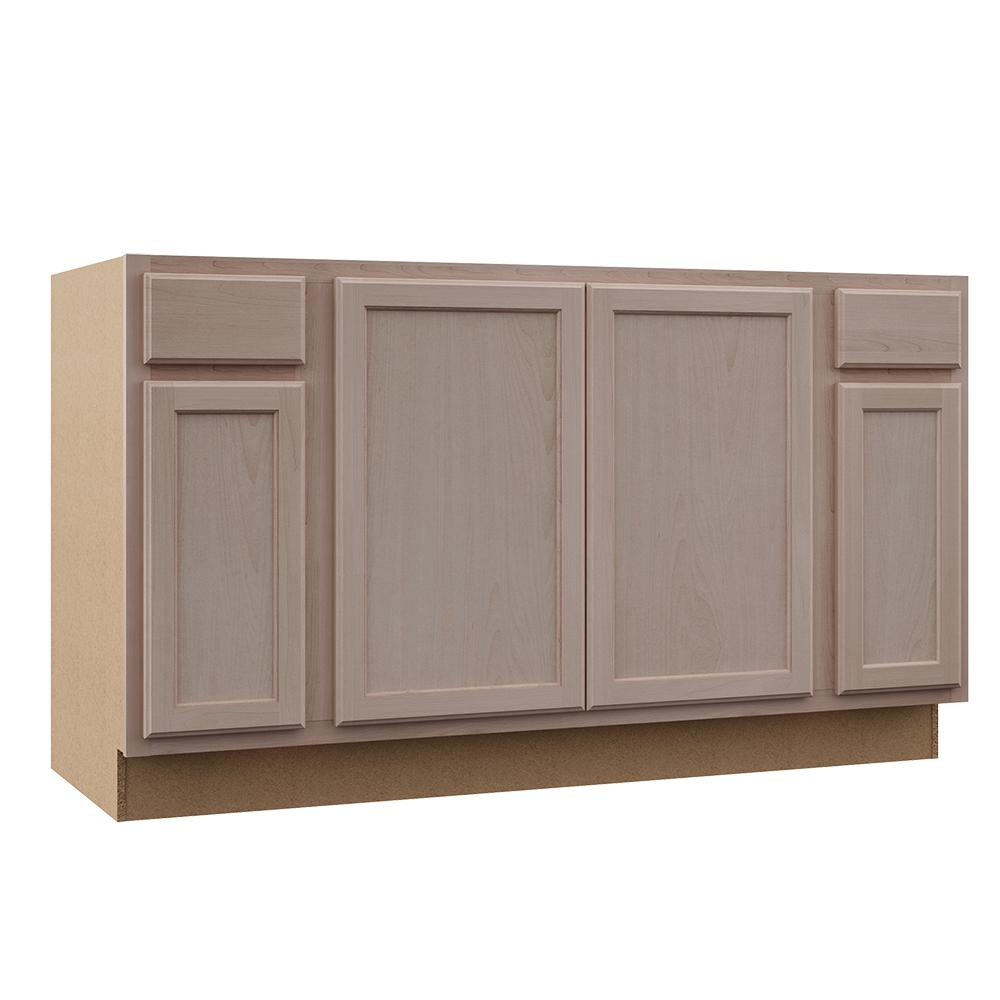Understanding the 60 Inch Kitchen Sink Base Cabinet Unfinished

The 60-inch kitchen sink base cabinet is a foundational element in any kitchen design, providing storage and support for the sink. These cabinets are typically unfinished, allowing homeowners to customize the look and feel to match their kitchen’s aesthetic.
Advantages and Disadvantages of Unfinished Cabinets
Unfinished cabinets offer flexibility in terms of customization, allowing homeowners to choose their desired finish, color, and hardware. However, this flexibility comes at the cost of additional effort and time, as the cabinet must be stained, painted, and sealed before installation.
Materials Used in 60 Inch Kitchen Sink Base Cabinets
The materials used in these cabinets vary depending on the manufacturer and price point. Common materials include:
- Plywood: A popular choice for its strength and durability, plywood is typically used for the cabinet’s frame and shelves.
- Medium-Density Fiberboard (MDF): MDF is a cost-effective option known for its smooth surface, making it ideal for painting.
- Particleboard: Particleboard is another budget-friendly option, but it is less durable than plywood or MDF.
Construction Methods
The construction of a 60-inch sink base cabinet typically involves:
- Frame Construction: The cabinet frame is built using a combination of wood pieces, often joined with dowels, screws, or glue.
- Sheathing: Plywood or MDF is used to cover the frame, creating the cabinet’s exterior.
- Doors and Drawers: Doors and drawers are constructed separately and attached to the cabinet frame.
- Hardware: Hinges, handles, and other hardware are installed to complete the cabinet.
Design Considerations
Designing a 60-inch sink base cabinet requires careful consideration of the following factors:
- Sink Size: The sink’s dimensions will dictate the size of the cabinet opening.
- Storage Needs: The cabinet should provide sufficient storage space for kitchen essentials.
- Accessibility: The cabinet should be easily accessible for loading and unloading items.
- Aesthetics: The cabinet’s design should complement the overall kitchen aesthetic.
Choosing the Right 60 Inch Kitchen Sink Base Cabinet

A 60-inch kitchen sink base cabinet is a significant investment, so choosing the right one is crucial. It needs to be both functional and aesthetically pleasing, fitting seamlessly into your kitchen design. This section will explore key factors to consider when making your decision.
Styles and Finishes
The style and finish of your 60-inch kitchen sink base cabinet can significantly impact the overall look of your kitchen. Here’s a comparison of common options:
- Traditional: Often characterized by ornate details, raised panels, and a classic, timeless look. They often come in warm wood tones like cherry or maple.
- Contemporary: These cabinets typically feature clean lines, minimalist designs, and sleek, modern finishes. Popular materials include painted finishes in white, black, or gray.
- Rustic: Rustic cabinets often embrace natural wood textures, distressed finishes, and a farmhouse aesthetic. They frequently feature reclaimed wood or distressed paint.
- Modern: Modern cabinets are known for their bold, geometric designs and sleek, often metallic finishes. They can incorporate innovative materials like high-gloss laminates or metal accents.
Key Features to Consider
- Cabinet Depth: Standard cabinet depths range from 24 inches to 25 inches. However, you can find deeper cabinets for larger sinks or increased storage space.
- Cabinet Construction: The quality of the cabinet’s construction is essential for its durability and longevity. Solid wood construction is the most durable, followed by plywood and particleboard. Look for cabinets with dovetail drawers, solid wood frames, and sturdy construction methods.
- Door and Drawer Styles: Consider the door and drawer styles that best suit your kitchen’s aesthetic. Options include raised panel, flat panel, shaker, and more. Think about the hardware, such as knobs or pulls, that will complement your chosen style.
- Storage Features: Assess your storage needs and choose a cabinet with features that suit them. Some cabinets offer adjustable shelves, pull-out drawers, or specialized organizers for maximizing storage efficiency.
Cabinet Construction and Durability
Cabinet construction is paramount for longevity and functionality. Here’s a breakdown of common construction methods and their pros and cons:
- Solid Wood: Solid wood construction is the most durable and provides a classic, timeless look. It’s also the most expensive option. Solid wood cabinets can warp or crack if not properly cared for.
- Plywood: Plywood is a durable and affordable option. It’s less prone to warping and cracking than solid wood. Plywood cabinets may not have the same aesthetic appeal as solid wood cabinets.
- Particleboard: Particleboard is the least expensive option, but it’s also the least durable. It’s prone to moisture damage and may not hold up well over time. Particleboard cabinets are often used in budget-friendly kitchen designs.
Selecting the Appropriate Sink Size
The size of your sink should be proportionate to the size of your cabinet. Here are some general guidelines:
A 60-inch base cabinet can accommodate a wide range of sink sizes, from a compact 25-inch single bowl sink to a larger 36-inch double bowl sink.
Countertop Material and Design
The countertop material and design should complement your cabinet style and overall kitchen aesthetic. Here’s a look at popular options:
- Granite: Granite is a durable and beautiful natural stone with a wide range of colors and patterns. It’s also resistant to heat and scratches.
- Quartz: Quartz is an engineered stone that is even more durable than granite and comes in a wide variety of colors and patterns. It’s also non-porous and easy to clean.
- Laminate: Laminate is a budget-friendly option that is available in a wide variety of colors and patterns. It’s also easy to maintain.
- Butcher Block: Butcher block countertops are made from wood and offer a warm, natural look. They’re also durable and can be refinished over time.
Installing and Finishing the 60 Inch Kitchen Sink Base Cabinet: 60 Inch Kitchen Sink Base Cabinet Unfinished

Installing and finishing a 60-inch kitchen sink base cabinet is a crucial step in creating a functional and aesthetically pleasing kitchen. This section will guide you through the process, from preparation to achieving a professional-looking finish.
Preparing the Cabinet for Finishing
Preparing the cabinet is essential to ensure a smooth and durable finish. This includes cleaning the surface, sanding, and priming.
- Thoroughly clean the cabinet’s surface with a damp cloth and mild detergent to remove dust, dirt, and debris. Allow the cabinet to dry completely.
- Sand the cabinet’s surface using progressively finer grit sandpaper to remove any imperfections and create a smooth, even surface. Start with a coarse grit (80-120 grit) and work your way up to a fine grit (220-400 grit). This will ensure a smooth, even surface for the finish.
- Apply a primer to the cabinet’s surface to seal the wood and create a uniform base for the finish. Choose a primer that is compatible with the type of finish you intend to use.
Finishing Techniques and Materials
The type of finish you choose for your cabinet will depend on your desired aesthetic and the level of protection you require. Here are some popular finishing techniques and materials:
- Painting: Painting is a common and versatile finishing technique. You can use latex or oil-based paints, depending on your preference. Latex paints are water-based, dry quickly, and are easy to clean up. Oil-based paints offer better durability and resistance to moisture.
- Staining: Staining is a great way to enhance the natural beauty of the wood while adding color and depth. There are various types of stains available, including oil-based, water-based, and gel stains. Oil-based stains penetrate deeply into the wood, while water-based stains are easier to clean up. Gel stains are thick and provide a more even finish.
- Varnishing: Varnishing provides a protective layer over the wood, enhancing its durability and resistance to moisture and scratches. Varnishes are available in various finishes, including gloss, semi-gloss, satin, and matte.
- Polyurethane: Polyurethane is a durable and water-resistant finish that is often used for kitchen cabinets. It is available in various finishes, including oil-based and water-based options.
Achieving a Professional-Looking Finish, 60 inch kitchen sink base cabinet unfinished
Achieving a professional-looking finish requires attention to detail and proper application techniques.
- Use a high-quality brush or roller: A good-quality brush or roller will help you apply the finish evenly and smoothly.
- Apply thin coats: Thin coats of finish will dry faster and produce a more even finish. Avoid applying thick coats, as they can result in drips and runs.
- Sand between coats: Sanding between coats helps to smooth out any imperfections and create a smoother, more durable finish.
- Let the finish cure completely: Allow the finish to cure completely before using the cabinet. This will ensure that the finish is fully hardened and protected.
Maintaining and Caring for the Finished Cabinet
Proper maintenance is essential to preserve the beauty and durability of your finished cabinet.
- Clean regularly: Regularly clean the cabinet’s surface with a damp cloth and mild detergent. Avoid using harsh chemicals or abrasive cleaners, as they can damage the finish.
- Protect from moisture: Avoid exposing the cabinet to excessive moisture, as it can damage the finish and warp the wood.
- Apply a sealant: Apply a sealant to the cabinet’s surface every few years to protect the finish and enhance its durability.
A 60 inch kitchen sink base cabinet unfinished is a blank canvas, ready for your creative touch. Perhaps you envision a sleek modern design or a rustic farmhouse aesthetic. The possibilities are endless, just like the possibilities of finding your perfect home in one bedroom apartments in North Canton, Ohio.
Once you’ve settled on your dream kitchen, you can start focusing on the finishing touches for your new space, like adding a custom countertop to your 60 inch kitchen sink base cabinet.
A 60 inch kitchen sink base cabinet unfinished might seem like a simple piece of furniture, but it can be the foundation for a truly grand kitchen. Imagine pairing it with sleek, modern appliances and countertops, creating a space that rivals the luxurious kitchens found in a 6 bedroom apartment in London.
The possibilities are endless, and with a little creativity, you can transform your kitchen into a culinary masterpiece.